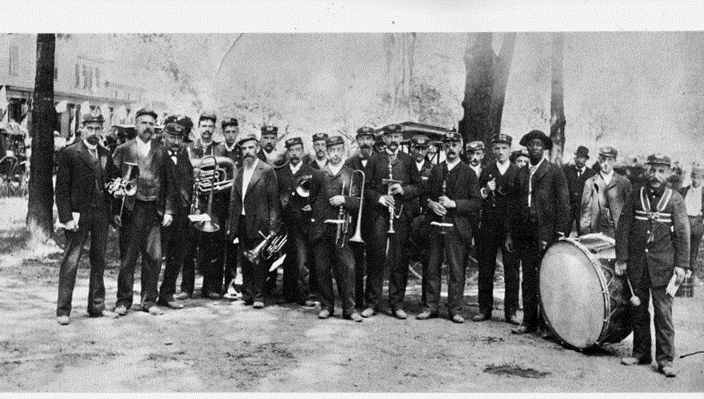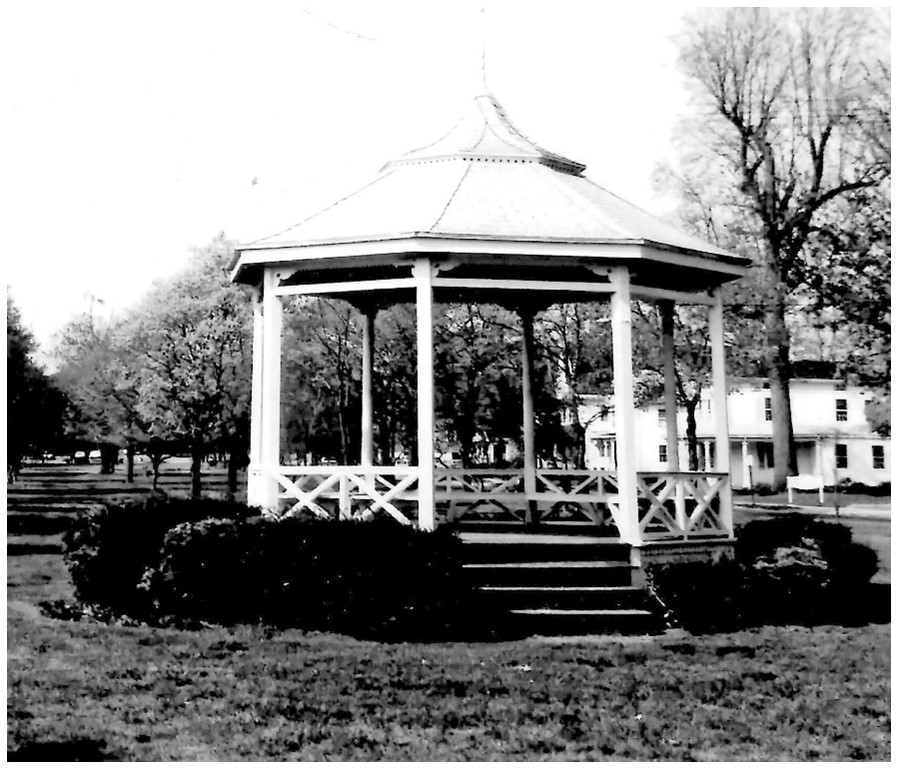By Marilyn May
Milford History

You can almost hear the beat of the drum as the Milford Cornet Band members get ready to play. Photo courtesy of the Daniel E. Moger Photo Collection.
The Milford Cornet Band is pictured here at rest, which was, perhaps, for the best. When looking up information on such bands, it was said of the Ashford, Connecticut Cornet Band: “Those who could read music, played by note; those who could not, played by ear; those who could do neither, made what noise they could. Cats, screech owls, and bull frogs all left town. Dogs crawled under the barn or ran away to the woods every time the band played.”
Fortunately, in the photo it looks like most of the musicians had sheet music with them. No doubt, the Milford band was an enthusiastic and fairly large group of spirited men.
A cornet is a three-valved brass instrument of the trumpet family, but as you can see this band had a tuba, trombone, clarinet and a big bass drum.
The man standing to the left of the drum was said to be among the last of the Paugussett tribe in Milford. His name was Henry Sherman. He had been on a reservation in Kent, but joined up during the Civil War where he lost his left arm. Because of his service, however, he gained “the freedom of the Town of Milford.” He remained in Milford, the home of his ancestors, and took immense pride in carrying the drum in the band.
He made his home in a hut along the Wepawaug River, above Kissing Bridge. It was said that sometimes late at night, he would let out a war whoop that “would make your blood run cold.” Never-the-less, he was peaceful and died peacefully.
Band Members Built Milford’s Early Bandstand

The bandstand on the Milford Green. There were several steps in front so that, as typical of most bandstands, the musicians were on a raised platform for all to see. Photo courtesy of the Daniel E. Moger Photo Collection.
A bandstand on the Green was built by the members of the Milford Cornet Band and was dedicated on Aug. 7, 1890. The Journal-Courier of Aug. 11 that year told the story: “The new bandstand was dedicated with much eclat and beating of cymbols. It is situated near the soldier’s monument and about (the bandstand) was congregated the larger part of the town’s population. The Milford Band outdid itself in the part of the performance that it had to render. Appropriate addresses were made by Rev. Ferguson and Messers Gunn and Clarke.”
That day was a great success, but not everything went smoothly in the planning stages. The New Haven Register of July 2, 1890 had this report: “The injunction case of Henry C. Platt against L.C. Smith, town agent of Milford, was heard this morning. Mr. Platt claims that his dwelling will be greatly damaged by constructing a bandstand on the green just opposite.”
Judge Sanford denied the motion, and the builders went back to work.
That bandstand graced the green for many years until the late 1990s, when someone lost contol of a car and smashed right into it, causing a lot of damage. The plan was to rebuild it, but upon examination it was found that wood rot was affecting the whole thing, making it unsafe.
It was torn down and today the structure is at ground level and accessible to the handicapped. Old-timers still call it a bandstand, but now it is more like a gazebo. By definition a gazebo is open on the sides, has a permanent roof, and is built on a site that provides an attractive view. The origin of the word gazebo is not clear, but some have said it developed from the word gaze.
And to add to the confusion, a gazebo can also be a bandstand – you just need a band small enough to fit.
Marilyn May is a lifelong resident of Milford and on the Board of the Milford Historical Society.